Blu-Ray video was introduced in 2006, at a time when we all were still watching movies on DVDs. With all of its advantages in video quality, it had one peculiar side effect in a very niche corner of a niche hobby: identifying watches in movies. The freshly remastered videos had watch enthusiasts pausing and inching forward, frame by frame, much to the annoyance of spouses who just wanted to enjoy a movie. It didn’t take long for Hooper’s Alsta Superautomatic to be ID’d in Jaws, and James Bond’s NATO strap in Goldfinger to be determined to have more stripes than originally thought. There are entire websites devoted to watches in movies and Hodinkee has even started a weekly column about screen-worn timepieces. But there’s perhaps an even more obscure offshoot of this rather arcane pursuit that few people talk about: the watches that appear in books.
Admittedly, watches on the page lack the visual excitement of catching a glimpse as a character swings his arm past the camera; think Arnie’s Seiko in Predator or Robert Redford’s Doxa in Three Days of the Condor. (I’m still trying to figure out what Redford wears in Downhill Racer.) Authors don’t necessarily have the compulsion to describe a watch by name or detail unless it advances the plot or helps develop a character. So it’s fairly slim pickings. Still, there are a few. The best known are probably Ian Fleming’s placement of a “heavy Rolex Oyster” on the wrist of his James Bond, which the hero uses as a knuckleduster in On Her Majesty’s Secret Service, and Clive Cussler’s selection of an orange-dialed Doxa for his own protagonist, Dirk Pitt.
For both the James Bond and Dirk Pitt of the page, the choice of watch is more than product placement brought about by a marketing agreement. These watches serve to tell us something about the characters themselves. Fleming was a master of using personal sartorial, culinary, and vehicular choices to flesh out who 007 is: pragmatic, unsentimental yet somewhat traditional, and definitely a man of specific preferences. The vaguely described Rolex is a perfect choice. It lacks flourish, is reliable, glows in the dark, and can serve a purpose beyond telling time (breaking a henchman’s jaw). For Dirk Pitt, the Doxa also tells us that this character, while suave, bold, and confident, is, first and foremost, a man of the sea, a diver. At the time Cussler was creating his first Pitt novels, Doxa was the dive watch worn by actual divers. I mean, who else would wear a bright orange watch with a complicated bezel, strange shape, and a dwarf hour hand, except someone who appreciated those “features” while timing a dive? Cussler himself wore one when he worked in a dive shop. The very specific and rather obscure choice of a Doxa gave Pitt a credibility as a diver, even to those who didn’t know much about diving, or watches.
When I set out to write my novel, Depth Charge, the choice of my protagonist’s wristwatch took on rather outsized proportions. I thought about it way too much. But I knew that, because I had built a reputation, and an audience, from writing about dive watches, and because Depth Charge is largely an underwater thriller, people would expect to see a well considered subaquatic watch on my hero’s wrist. In fact, even when I started publicizing the book over a year ago, some of the first questions and feedback I got revolved around my choice of watch. Never mind compelling characters or a well developed plot, I felt pressure to pick an appropriate dive watch for my main character! Now that the book is published and in the hands of a few thousand readers, I can comfortably say that I’m happy with that element of the book. It wasn’t easy though.
When creating an entire fictional world full of people, places, and events, the freedom to choose also becomes something of a burden. What kind of vehicle should so and so drive? OK, that one was easy. How about physical appearance? Does my protagonist look like me? That always feels a little vain and slightly ridiculous when authors do that—an aging writer placing himself in a world of action and love trysts. What does he wear? Clothing reflects the setting and the weather, but also the character’s tastes. I know how I dress in the tropics, the way clothes stick to your skin, and you go through three cotton shirts a day due to sweating. Headwear? All-American baseball cap or some sort of Indiana Jones romanticism? For the diving scenes, apparel choices were easy enough—two-millimeter wetsuit or three? But even here, a brand name of fins or dive computer can be an Easter egg or a nod to the few readers who know a poser from a legit diver. In the book, I have my hero, Tusker, wearing a faded red Mount Gay Rum cap. It’s a small element, but hints at his nautical leanings and multi-sport cred, since those caps are given away or won at various international sailing races (his specifically from the tough Chicago-Mackinac Race). Certain ones go for big money on eBay. And of course, it plays a small role in the story too.
Whenever I read Fleming’s Bond novels, I’m always struck by his attention to detail—the Marchal driving lights on Bond’s Bentley, for example, or a type of speargun or aircraft. The best books are those I only put down in order to go down a rabbit hole to research a specific reference. Bond too, notices details, sizing up his enemies using small hints from their hairstyle, clothing or even watch choice. In From Russia With Love, we learn that the assassin, Red Grant wears, “…a bulky gold wristwatch on a well-used brown crocodile strap. It was a Girard-Perregaux model designed for people who like gadgets, and it had a sweep second-hand and two little windows in the face to tell the day of the month, and the month, and the phase of the moon.”
I don’t deign to compare myself to Ian Fleming, but in my own way, I tried to paint a picture of my characters in Depth Charge through their choices. Samanthi drives a battered old Land Rover, wears aviator sunglasses and a Seiko dive watch on a loose steel bracelet. What do these choices say about her? Tomboy? Pragmatist? What about my arch-villain, Rausing, with his “big Rolex,” choice of inappropriate clothing for the tropics, and a luxed-out Land Cruiser? Finally, what about Tusker’s watch?
Like Cussler’s Dirk Pitt, Julian Tusk is a working diver, someone who spends a lot of time underwater for a living. I wanted him to wear a watch that suits that lifestyle, and one that also reflects an unpretentious yet sentimental attachment to it. It is, as I tell it, a family heirloom from his diver father, one that was bought for use a generation earlier, still maintained and taken deep up to the present. It’s from a brand that arguably had more credibility than most other dive watches of its day in the early 1970s but then faded away, as so many brands did. I didn’t want the obvious choice for Tusker and, believe me, he changed watches more times in my year of writing than I did. First it was a Seiko, then a Rolex. Personal favorites like a CWC or Bremont crossed my mind, but felt a little too “inside baseball,” too self consciously watch nerdy and autobiographical. A Doxa? It’s been done—famously. Then I thought I had settled on the “one”: a Citizen Aqualand, that beloved analog-digital icon of the mid-80s. In early drafts, I even had Tusker using its depth gauge on the deep dives.
Finally I settled on something different, something from an earlier era, an incredibly functional and capable watch, unmistakable yet obscure enough that non-watch people might be tempted to Google it. Read in today’s context, the choice of a fairly rare vintage watch may seem odd but I wanted the watch to have a tie to Tusker’s own history and to his father. I also wanted to show a bit of his ethos, through his continued maintenance and use of an old watch. You can call that part autobiographical if you wish.
If you’ve read Depth Charge, you’ll know the watch in question. I was tempted to keep it a secret even here, enticing curious readers to buy the book to find out. But that feels a little too much like the secretive embargoes that the Swiss brands like to impose on their new releases. Anyway, a few people have “leaked” it out on social media. Spoiler alert! It is, of course, an Aquastar Benthos 500, a watch made in the early 1970s. This was a watch to which I never warmed until very recently. Truth be told, if I’m picking an Aquastar for myself (and did) it’s the Deepstar. But that’s an older watch, introduced in the mid-60s, and feels of that generation. I liked the idea that Tusker’s dad wore the Benthos in the bell-bottomed, mustachioed early ‘70s, and then passed it on to his son years later. It’s a big, burly watch, all business, with a depth rating suitable for the sort of diving that occurs in Depth Charge. And then, of course, the watch also plays a small role in the plot, a bit of a vehicle to dredge up memories and build Tusker’s character. But I didn’t want to overdo it and make Depth Charge a “watch book.” Hopefully I struck the right balance and it meets the approval of both the uninitiated and the horological cognoscenti. And, if not, there’s always the sequel. And Tusker’s going to need a new watch.

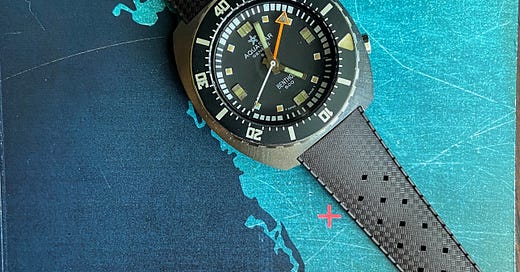


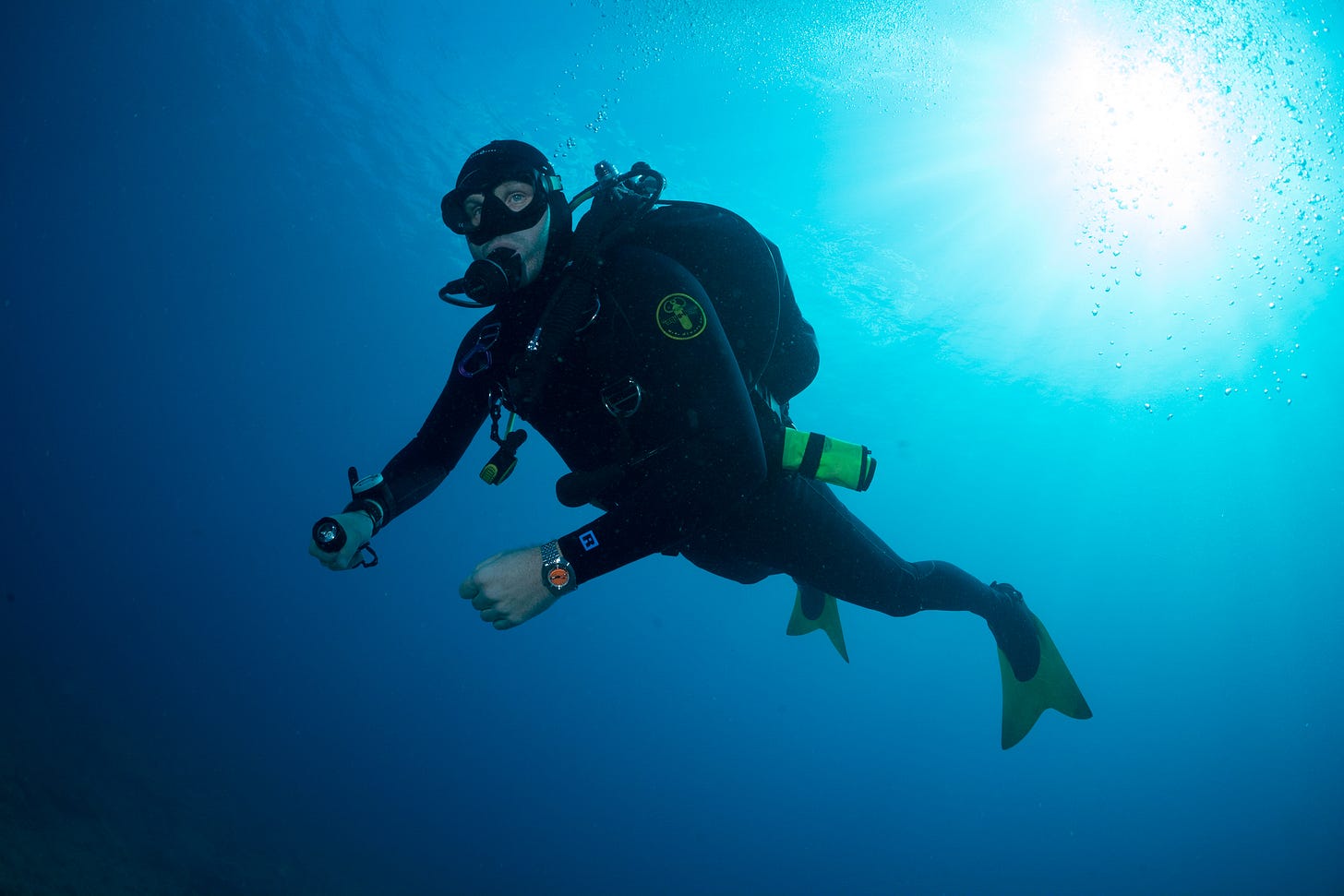
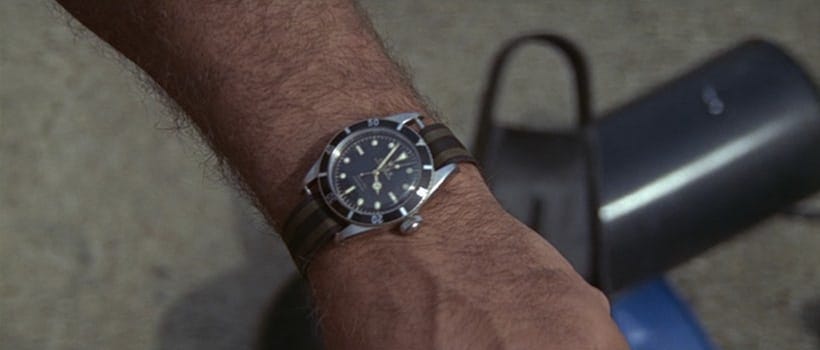
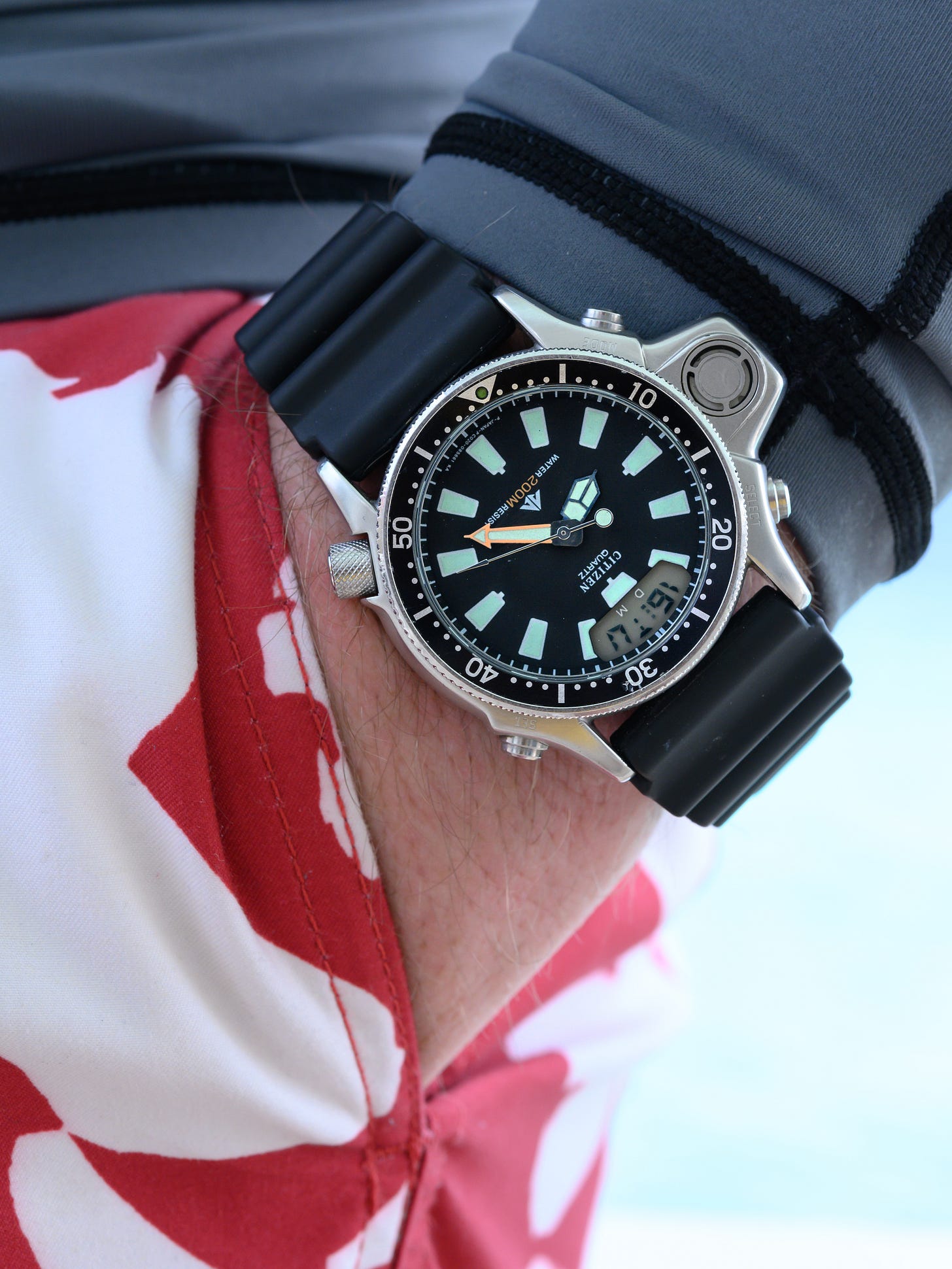
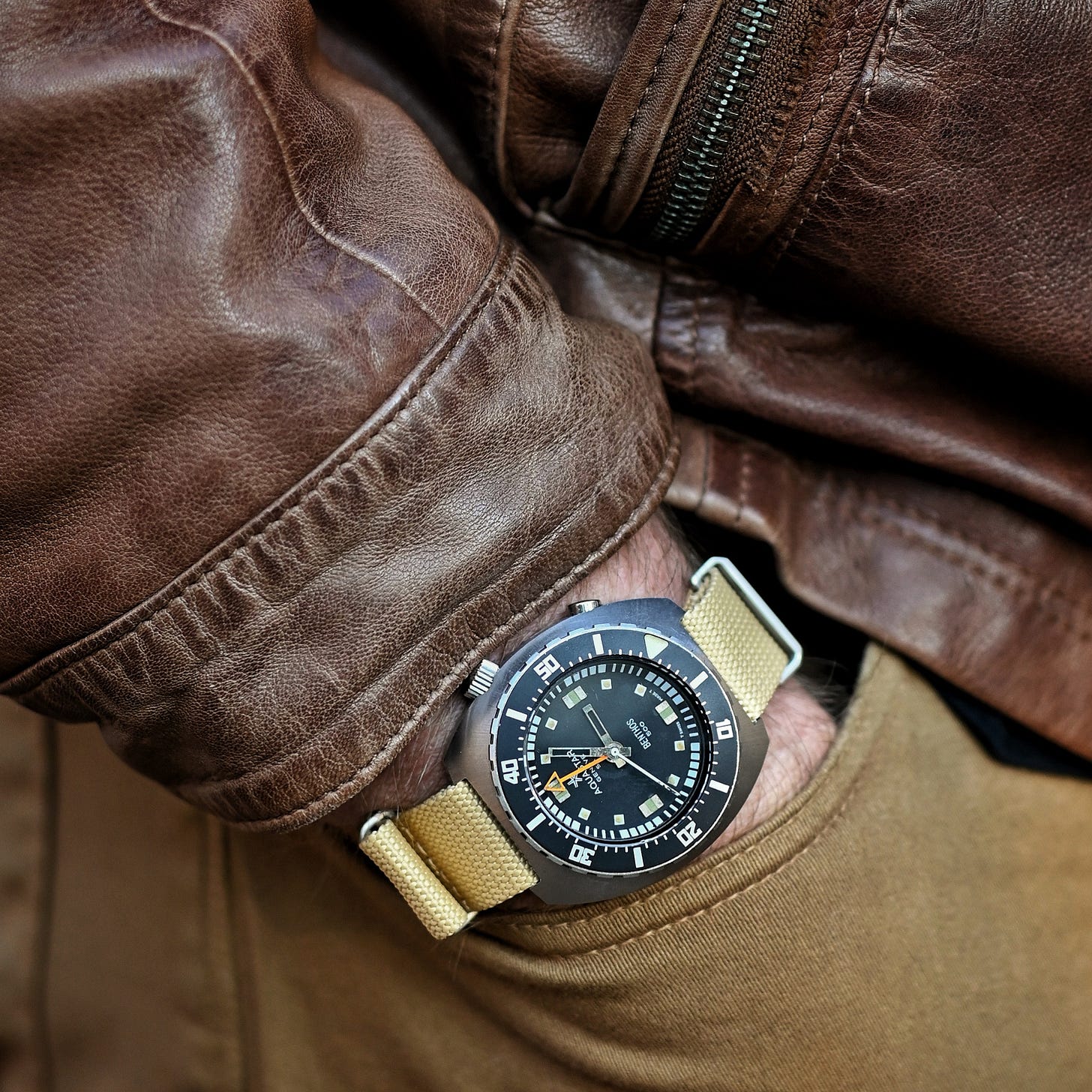
I wish Tusker hadn’t lost his dad’s watch but at least he survived Depth Charge to live another adventure!
Yay sequel!!!